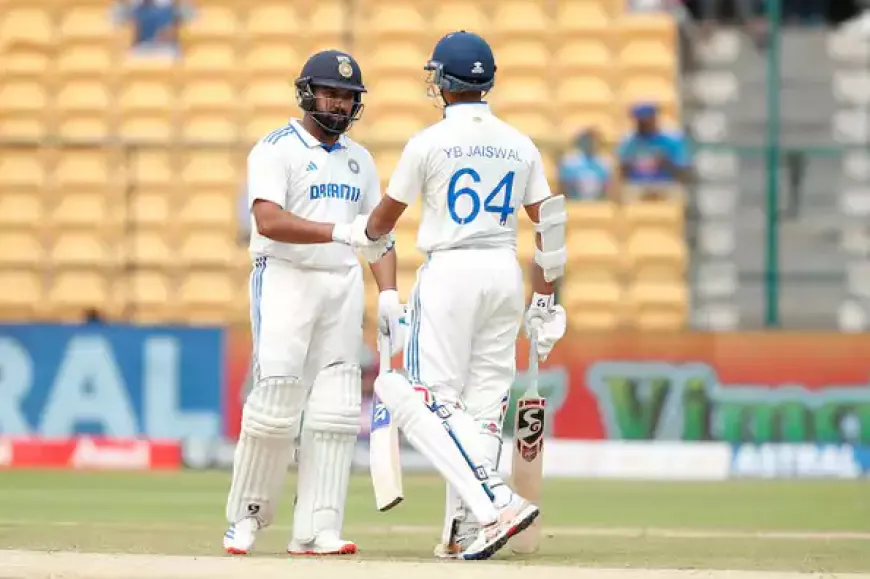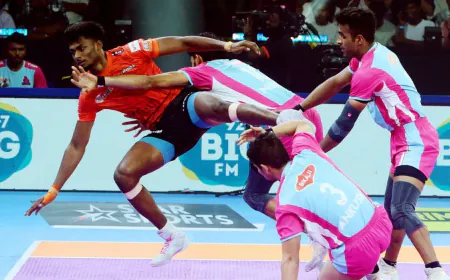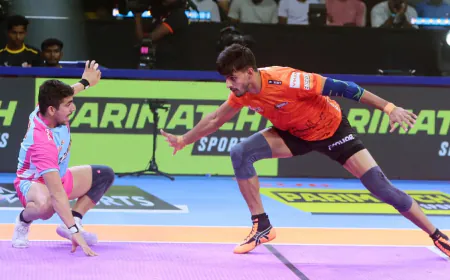India Starts Steadily in Massive Chase Against New Zealand
The Road Ahead for India As the match progressed, India was acutely aware of the challenges that lay ahead. The batting lineup, which had faltered in the first innings, needed to regroup and exhibit resilience to tackle New Zealand’s potent bowling attack. The partnership between Rohit and Jaiswal offered a glimmer of hope, but they needed to build on this foundation to counter the impending pressure.

After an abysmal batting performance in their first innings that resulted in the lowest-ever Test total by any team in Asia, India found some solace in a steady second innings during the first Test against New Zealand in Bengaluru. With a monumental first innings deficit of 356 runs to chase down, the Indian side entered their second innings determined to rectify the errors of the past.
As the players headed into the final hour before the tea break, openers Rohit Sharma and Yashasvi Jaiswal put together a promising 57-run partnership. Both batsmen approached the task with composure, managing to remain unbeaten at 27 and 29, respectively, as India reached 57 without loss at the break. The sun shone brightly on the pitch, which appeared to have settled down, allowing the Indian duo to play with more freedom.
Despite a cautious start, Rohit began to open up, executing a series of elegant drives and flicks that kept the scoreboard ticking. Jaiswal, on the other hand, seemed slightly out of sorts early on, showing some streakiness but gradually finding his rhythm as the innings progressed. The scoring rate of almost four runs per over indicated that India was not getting bogged down, which is crucial when faced with such a daunting target.
While batting conditions had improved somewhat, there were still signs of uneven bounce that could pose challenges as the match continued. With two days left, the pitch was expected to deteriorate further, suggesting that spin bowling would soon become a significant factor in the contest.
New Zealand’s First Innings Dominance
In the first innings, New Zealand had shown their batting prowess, amassing a total of 402 runs, with Rachin Ravindra leading the charge. Ravindra's aggressive approach after lunch was instrumental in extending New Zealand’s already substantial lead, allowing them to pile on runs swiftly. His century, which included an impressive 134 runs, exemplified his ability to adapt and dominate.
Tim Southee also contributed significantly, scoring a half-century before departing shortly after reaching the milestone. As the innings progressed, Ravindra transformed his style, adopting a more aggressive, T20-like approach to capitalize on the situation. This shift in mentality saw him take on the Indian spinners, peppering the field with powerful shots.
India missed a crucial opportunity to review an LBW decision against Ravindra when he was on 110 runs, a decision that ultimately proved costly as he added another 24 runs to his tally before being dismissed by wrist spinner Kuldeep Yadav. Despite being the last wicket to fall, Ravindra's innings had inflicted significant damage on the Indian bowling attack.
With a staggering deficit of 299 runs to chase, India found themselves in a precarious position. The upcoming session was pivotal for the home side, as they needed to establish a strong foothold in the match to enter the fourth day with any realistic chance of salvaging the game.
The Road Ahead for India
As the match progressed, India was acutely aware of the challenges that lay ahead. The batting lineup, which had faltered in the first innings, needed to regroup and exhibit resilience to tackle New Zealand’s potent bowling attack. The partnership between Rohit and Jaiswal offered a glimmer of hope, but they needed to build on this foundation to counter the impending pressure.
Given the pitch conditions and the inherent unpredictability of the game, the Indian batsmen had to remain vigilant and adaptable. Every run was vital as they sought to close the gap and put pressure back on the New Zealand side. As the sun continued to shine, it was crucial for India to maintain their composure and play each ball on its merit.
New Zealand’s Strategic Edge
New Zealand, on the other hand, would be keen to maintain their momentum and capitalize on any weaknesses in the Indian batting lineup. With a formidable lead, their bowlers would be eager to exploit the conditions and the psychological edge gained from their dominance in the first innings. The bowlers' strategy would likely involve targeting the uneven bounce and trying to create pressure through early wickets.
As the match entered a critical phase, both teams were aware of the significance of the next few sessions. For India, a strong performance in the upcoming session was essential to keep their hopes alive in the match. If they could build partnerships and steadily chip away at the deficit, they could potentially shift the momentum in their favor.
Current Match Situation
At the close of the day, India found themselves at 57 runs without loss, still trailing New Zealand's first innings total by 299 runs. Rohit Sharma and Yashasvi Jaiswal were at the crease, cautiously optimistic but aware of the task ahead. With seven sessions remaining in the Test, India needed to approach the next phases with determination and focus.
Brief Scores:
India 46 and 57/0 (Yashasvi Jaiswal 29*, Rohit Sharma 27*) trail New Zealand 402 (Rachin Ravindra 134, Devon Conway 91; Ravindra Jadeja 3-72) by 299 runs.
As the match progresses, it remains to be seen if India can overcome their earlier woes and mount a formidable challenge to chase down the mammoth target set by New Zealand. With a blend of cautious batting and aggressive intent, the Indian side must find a way to turn the tide in their favor and aim for a remarkable comeback in this first Test.





















































